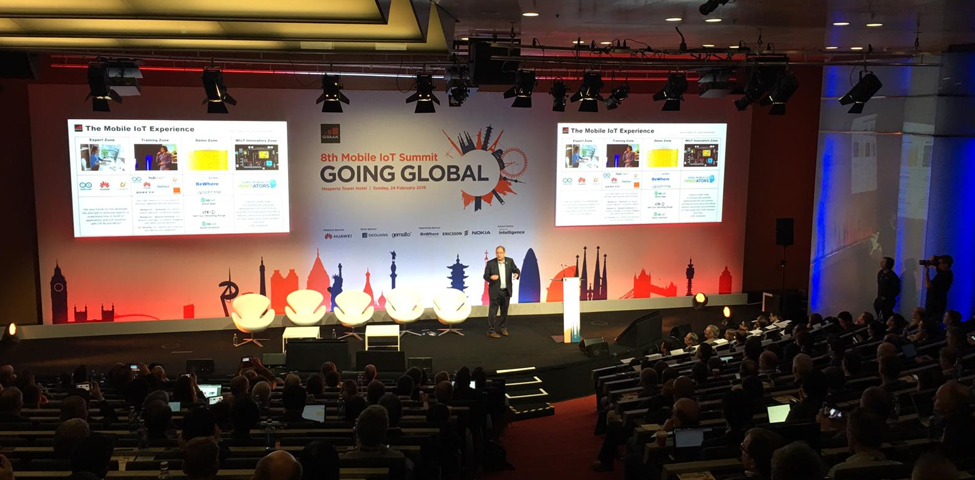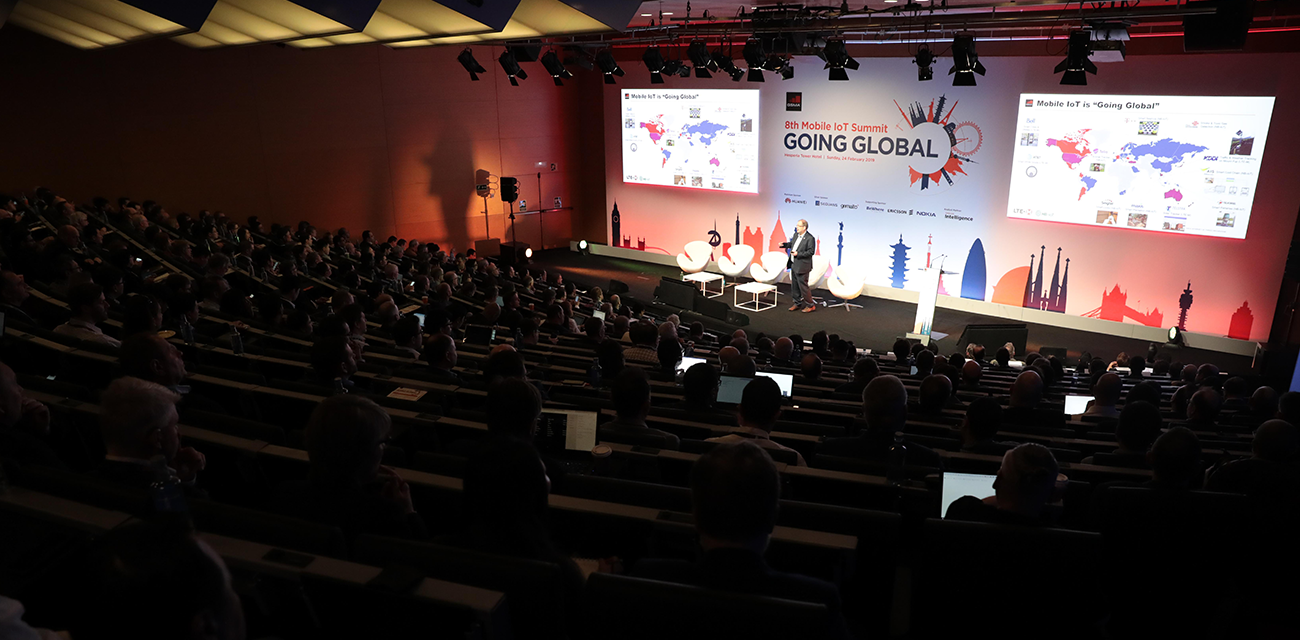“How many people here refer to Mobile IoT in their day-to-day activity?”, asked one panellist of our 500-strong audience at yesterday’s 8th Mobile IoT Summit. “That’s about half – two years ago when we asked this question, only about five people put their hands up”. Perhaps the main takeaway from the session, then, was this: Mobile IoT is now truly going global. There have now been 94 commercial launches across the world, by 50 different operators, with ongoing rollout supported by 47 IoT labs in 21 countries. In fact, 93% of the world’s cellular IoT connections now have access to at least one network that supports Mobile IoT – the work of the last year has yielded a global solution available as a public capability.
At a human level, this growth means today there are around 2,100 developers of Mobile IoT solutions globally, across more than 1,300 companies. This equates to a blossoming variation in the range of use cases coming to market: the GSMA’s Graham Trickey opened yesterday’s Summit with a visual assessment of this global picture: take-up of Mobile IoT is spreading rapidly, with more and more countries using both LTE-M and NB-IoT side-by-side. By 2025, there will be 3.1 billion IoT connections globally, and of these a clear majority will be Mobile IoT, at 1.8 billion. Especially striking growth has been seen in Asia Pacific, the largest IoT market in the world, where uses as various as smart litter bins and toilets to intelligent pet-tracking are now increasingly commonplace.
As the world moves increasingly to recognise and adapt to the challenges of climate change, the industry can be proud of the role it’s playing through Mobile IoT. Sustainability – whether through connected beehives for crop pollination, smart fisheries to manage feeding, weather tracking for better deployment of transport, and much more – is firmly within the sights of the mobile industry, and Mobile IoT is providing the means for its delivery.
This derives not only from the many uses to which it can be put, but the intrinsic qualities of the technology itself. The very low power requirements of Mobile IoT modules means they can be deployed in vast quantities and then simply left to do their job for upwards of a decade, without any need to recharge or replace batteries – and the very low cost of producing each unit means this can be done at such scale that we are already seeing quite profound reductions in the volume of batteries going to landfill sites. Telefonica’s Head of Global IoT went as far yesterday as to forecast a twenty-fold saving in energy use through Mobile IoT over the next decade.
As Huawei’s Veni Shone pointed out, this move in the direction of sustainability is already yielding tangible gains: one deployment of smart metering in the Chinese city of Yingtan alone, for instance, currently saves 2 million tonnes of water per year. These smart meters were showcased at the session alongside Huawei’s latest connected smoke detectors, electric bike trackers and more. Mobile IoT provides a tremendously encouraging example of how sustainability can be achieved through more production, not less – Huawei shipped 15 million NB-IoT chipsets last year, and expect this to rise dramatically to 100 million this year. “Our goal is to become carbon neutral,” announced Mr Shone, “and we’re with our partners in innovation we’re already becoming far more efficient.”
The business potential of Mobile IoT is now far further along than it was this time last year, and the market opportunity sits today at $1.1 trillion by 2025. One of the reasons for this is that Mobile IoT can act as a gateway to the Internet of Things more broadly – more that 80% of the IoT’s value is found beyond connectivity, and operators are working with their partners to realise this through data platform and services. Operators – through their technical expertise, unparalleled security credentials and existing global networks – are now supporting a far broader range of organisations to take part in the IoT than has previously been possible.
Cameron Coursey, AT&T’s Vice President for IoT explained that there are four principal barriers to entry into the IoT market: the need to ensure security, the skillsets which are currently lacking, interoperability requirements and the costs of deployment. Mobile IoT can help to address all four of these. Mobile IoT is unquestionably the trusted form of IoT, relying as it does on the unrivalled security and privacy capacity of mobile networks, and the commitment operators have made to interoperability through 3GPP, and the simplicity of the technologies helps to allow the barriers of cost and skills as well.
AT&T’s Mobile IoT connections are now growing by around a million per month, and have been since the middle of last year – with launch of NB-IoT coming up soon. “We think these two technologies are better together – they’re complementary,” noted Mr Coursey. AT&T’s smart parking payment system was on display at the Summit, a smart meter which easily retrofits onto existing parking meters.
But for Mr Coursey the future is now more consumer-facing: “We really think wearables are going to take off in this space – bear in mind how, not long ago, devices like this were much less cost-effective than they are now. The next thing is to pay more mind to the consumer side of these technologies, which we weren’t always able to support before – the focus has until now been on industry, but now we have the means to move into all these other areas. I for one am excited about the opportunities here!”
The big picture is important, of course, but we find delegates are often particularly intrigued by the latest case studies of what’s taking place on the ground. Our first panel – composed of leaders from Ericsson, Nokia, connected asset-tracking developers BeWhere and Deutsche Telekom’s IT subsidiary T-Systems – focused on the existing business opportunities, and how value is being maximised today.
And the successes here are striking: BeWhere for instance has seen revenue growth of 72% since posting its first set of financial results, and a 25% increase in share value. “We’re starting to see awareness ramp-up rapidly,” noted BeWhere’s CEO Owen Moore. “And the good news is, for those just starting out in Mobile IoT, it’s not too late. In fact a lot of the growing pains have now mostly been resolved – cooperation with operators for instance is now really in place, so if you’re thinking about doing this you’re starting at the right time.”
This view is reflected among operators themselves, who have collaborated to produce the Mobile IoT Toolkit to aid this process. Nokia’s Ankur Bhan reflected that “we started with connectivity of course, and managed services, but this year we’re announcing expansion into the vertical applications – we’re really excited about smart homes, which will be taking off for us very soon, along with smart agriculture and asset management.”
The future then looks bright for Mobile IoT. Orange’s Head of Technical Strategy Ronan Le Bras was clear, during his presentation on monitoring of mobile industrial equipment: “LTE-M a future-proof technology, which is important to us, and it’s complementary to other relevant technologies – it paves the way to 5G.”
This was one of the principal points of consensus – where some operators have prioritised LTE-M, and others NB-IoT, there is agreement that they are complementary to one another, and will sit cooperatively alongside 5G. “LTE-M is a great stepping stone to 5G,” agreed Verizon’s Steve Szabo on our second operator-led panel on the future of Mobile IoT. “We’ve prioritised NB-IoT,” answered Vodafone’s Head of IoT Innovation Lory Thorpe, “but they are indeed complementary.”
In fact in her closing remarks Ms Thorpe encapsulated our final key takeaway: “the level of cooperation in something I’ve not seen before, and it’s made a huge difference – and it’s refreshing to hear that everyone has the same challenges!” As with any technological business proposition reliant on bringing together multiple stakeholders across a complex global ecosystem, Mobile IoT will thrive best when fragmentation is minimised – and as the evidence considered at yesterday’s Summit illustrates clearly, that work is well under way.
Read more:
8th Mobile IoT Summit – Presentation Video
Wednesday 27 Mar 2019 | MIoT Technology | Resources |
The Mobile IoT Summit is the place to hear the latest industry updates from senior IoT experts. Topics explored include extensive global deployments and the new business opportunities these provide.
Presentations
Presentation 001 Amaia White_GSMA_Opening
Presentation 002 Graham Trickey_GSMA
Presentation 003 Veni Shone_Huawei
Presentation 004 Cameron Coursey_AT&T
Presentation 005 Orange
Presentation 006 Georges K_Sequans
Presentation 007 Andreas Haegele_Gemalto


